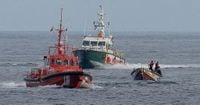In a tragedy that has become all too familiar along the West African coast, a vessel carrying migrants from The Gambia capsized off Mauritania earlier this week, resulting in the deaths of at least 69 people, with dozens more still missing. The incident, which occurred late Tuesday night near the coastal town of Lemhaijratt—about 80 kilometers north of Mauritania’s capital, Nouakchott—has once again thrown a harsh spotlight on the perilous journey many undertake in hopes of reaching Europe.
According to the Mauritanian coast guard, the wooden pirogue had set sail from The Gambia roughly a week before the disaster, carrying an estimated 160 people, most of whom were Senegalese and Gambian nationals. As the boat neared the Mauritanian shore under cover of darkness, the passengers spotted the lights of Lemhaijratt. In a moment of desperate hope, everyone rushed to one side of the already overcrowded and unseaworthy vessel, tipping the balance fatally. The boat capsized in the Atlantic’s cold, unforgiving waters, plunging all aboard into chaos.
Mohamed Abdallah, the head of the Mauritanian coast guard, described the sequence of events in stark terms. “When the migrants saw the lights of the Mheijrat, they tried to move to one part of the boat, causing it to capsize,” Abdallah told reporters, as quoted by The Guardian. The initial death toll, reported on Friday, was 49, with only 17 survivors rescued by coast guard patrols. But as recovery efforts continued, the number of recovered bodies rose to 69, according to a revised statement provided to the AFP news agency later that day.
Search and rescue operations are ongoing, but the outlook is grim. With an estimated 74 people still missing and the passage of time diminishing the likelihood of further rescues, Mauritania’s coastline has become the site of yet another mass tragedy. The Mauritanian coast guard confirmed to The Associated Press that 49 bodies had washed ashore in the immediate aftermath, but the relentless Atlantic waves have made recovery efforts both harrowing and incomplete.
This disaster is not an isolated event. Mauritania, with over 700 kilometers of Atlantic coastline, has become a major transit point for migrants from sub-Saharan Africa seeking a better life in Europe. Their primary destination: the Spanish Canary Islands, which lie tantalizingly within reach for those willing to risk one of the world’s most dangerous migration routes. The journey is fraught with peril, from treacherous ocean currents to rickety, overcrowded boats that are seldom seaworthy.
The scale of the human cost is staggering. According to Caminando Fronteras, a Spanish non-governmental organization monitoring migration, more than 10,000 people died or went missing at sea in 2024 alone while attempting to reach Spain. The International Organisation for Migration (IOM) reported at least 8,938 deaths for the same year, highlighting the grim frequency of such disasters. The year 2024 also saw a record number of arrivals in the Canary Islands, with 46,843 migrants making the crossing. While Spanish authorities have noted a 34.4% decrease in arrivals for the first part of 2025 compared to the previous year, the latest shipwreck underscores that the journey remains as deadly as ever.
This week’s tragedy echoes a similar incident in July 2024, when more than a dozen migrants died and 150 were declared missing off the coast of Mauritania. The repetition of such events points to systemic issues—poverty, instability, and lack of opportunity in migrants’ home countries—that continue to drive people towards Europe despite the deadly risks. Many of those who attempt the journey through Mauritania come not only from The Gambia and Senegal but also from neighboring Mali, drawn by the hope of a better future but too often meeting a tragic end.
For those who survive the Atlantic crossing, the dangers are far from over. Some migrants also brave the Sahara Desert, which covers 90% of Mauritania’s territory. Temperatures soar above 45°C (113°F), and the journey is equally perilous. The desert, much like the sea, is an unforgiving environment for those traveling without adequate food, water, or shelter.
Beyond the natural hazards, migrants face additional challenges from authorities. Human Rights Watch (HRW) released a 142-page report on August 27, 2025, documenting abuses by Mauritanian security officials during crackdowns on migrants. The report details “police use of prolonged, painful restraints, limited food and water, and other mistreatment,” a crackdown that has been funded by a €210 million deal with the European Union since 2024. According to The Guardian, the HRW report has sparked considerable debate in both government and humanitarian circles. As of now, authorities in Nouakchott have yet to respond publicly to these allegations.
Europe’s involvement in funding Mauritania’s border security has drawn criticism from rights groups, who argue that such measures may be compounding the dangers faced by migrants. While the EU’s intention is to stem the flow of irregular migration, critics contend that increased enforcement has simply pushed migrants to take even greater risks, leading to more deaths at sea and in the desert.
The survivors of this week’s disaster, rescued by the Mauritanian coast guard, now face an uncertain future. Many will be detained or repatriated, while others may attempt the journey again. Each statistic—each number in a grim tally—represents a human life, a story of hope and hardship, and a reminder of the desperate lengths to which people will go in search of safety and opportunity.
As the world’s attention turns briefly to Mauritania’s windswept shores, the broader crisis remains unresolved. The deadly migration route to Europe, stretching from the coasts of West Africa to the Spanish Canary Islands, continues to claim lives with distressing regularity. The question remains: how many more tragedies will it take before meaningful change is enacted, both in the countries of origin and in the policies of those who would seek to deter migration?
For now, the Atlantic has claimed dozens more souls, and Mauritania’s coast stands as a somber testament to the hopes—and heartbreak—of those who dared to dream of something better.




